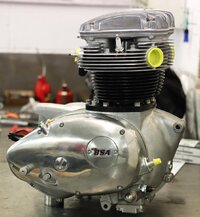Interesting, quick read...
https://www.cycleworld.com/blogs/ask-kevin/motorcycle-engine-shapes-explained/
https://www.cycleworld.com/blogs/ask-kevin/motorcycle-engine-shapes-explained/

Great read. ThanksInteresting, quick read...
https://www.cycleworld.com/blogs/ask-kevin/motorcycle-engine-shapes-explained/
Had BSA’s and a few 72 and back Triumphs and many XS’s.Hadn’t given even the slightest notion to look at them in a way of comparison until now. I do agree with your analogy.Enjoy pondering and reminiscing in my aging mind on the whole subject.BSA A65 engine:
View attachment 260177
It has only recently occurred to me that our beloved XS lump bears perhaps a passing resemblance to BSA's 'power egg'?
In the early '60s, the pre-unit British twin, with separate engine, primary/clutch and gearbox was getting decidedly long in the tooth, as well as being cumbersome, leaky and needing old fashioned know-how to work on. Manufacturers decided to clean up the whole design. However, motorcyclists as a group are traditionalists, so Triumph's new unit engines used subtle bulges in the castings to echo the look of the old separate gear box. Ah, the visual impact made by subtle bulges here and there . . .
Meanwhile, BSA management went for a clean-sheet, more streamlined, integrated and 'modern' look. Which became known as the power egg. Perhaps someone who knows stuff will be able to tell us whether BSA originated that term in their own marketing?
But in that way, the XS650 engine resembles a Beezer more than a Trumpet?
Thanks! It's been too long since I read Kevin Cameron, or Peter Egan, for that matter.Interesting, quick read...
https://www.cycleworld.com/blogs/ask-kevin/motorcycle-engine-shapes-explained/
I don't have a RE but have a 22 Bonneville and 21 Scout. When I can kick one of my kids out of the garage an garner more storage space, I want to get one.View attachment 260202
Very eye appealing!
our beloved XS lump bears perhaps a passing resemblance to BSA's 'power egg'?
Of course the BSA could manage a spectacular job of exploding its bottom end when abused, something that the XS hardly ever does
I’ve lusted after all of those!I don't have a RE but have a 22 Bonneville and 21 Scout.
I think it might have been Devimead who did the roller bearing conversion first?The unit construction BSA’s “ the power egg “ had a plain on one end of the crank that was prone to oil starvation during sustained high speed operation. I cannot recall the name of the British company that had a modification for that . . . Who doesn’t love a BSA?
Nice! Would be fun to ride one of those Indian Scouts. One day I'll have to take a test ride.I don't have a RE but have a 22 Bonneville and 21 Scout. When I can kick one of my kids out of the garage an garner more storage space, I want to get one.
Both the Bonneville and Scout are Liquid cooled but the Bonneville still has the fins on the head and the radiator is really hard to notice right away unlike the Scout.
The Scout has NO fins at all (wish they put some decorative fins on the sides). Scout has a very flat torque curve and I seldom go over 4500RPMS on it and its torque is pretty flat from 2K up. Scout is said to be a service nightmare when you hit 15K scheduled service.
For looks, I think the Bonneville engine keeps the modern classic look very well. I can however really appreciate Royal Enfield's dedication to serviceability that its market in India really needs/wants. I may be wrong but I feel that a RE that is 40 years old in 2060-2070 will fare better than many other bikes of this era.
I'm an Engineer in Manufacturing outdoor payment Kiosks. I preach Manufacturability, Serviceability and Reliability. But often the sales folks and the Industrial designers get in the way of that and force things to look "sexy" thinking that is the most important thing to sales. (I feel its the Reliability that keeps customers coming back).
Free shipping right now too
I love the look of many vintage Ducati engines. I’m partial to the round case bevel drive motors. Primitive yet sophisticated.You are pretty certain that you know what is happening here...View attachment 260299...and here...View attachment 260300...and might have a little bit of awe what's happening here...View attachment 260302...but might be a little in the dark where this come up,,,View attachment 260303
